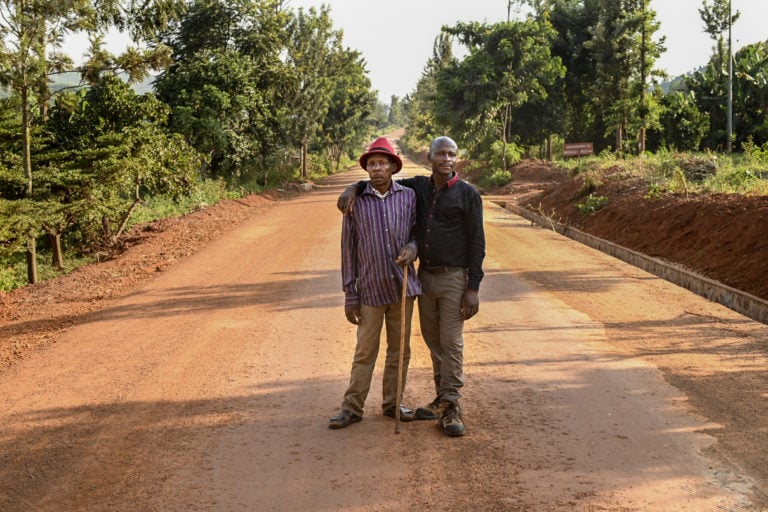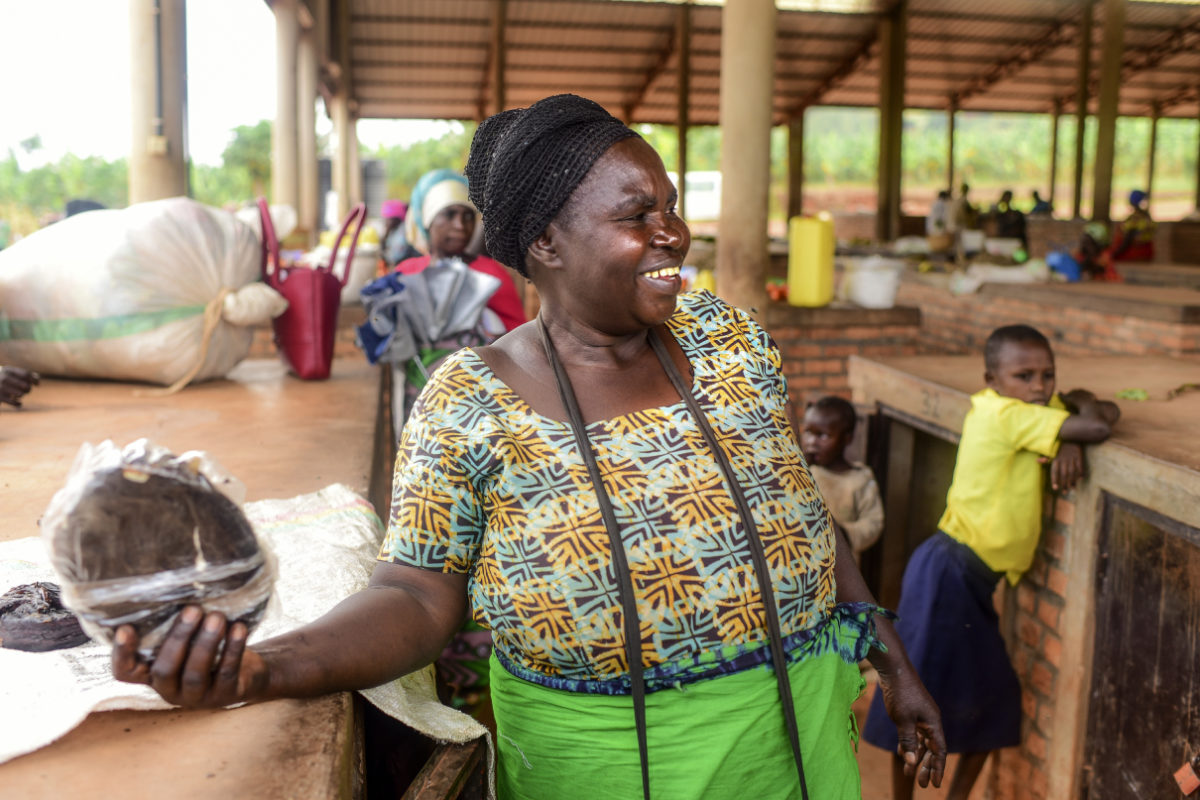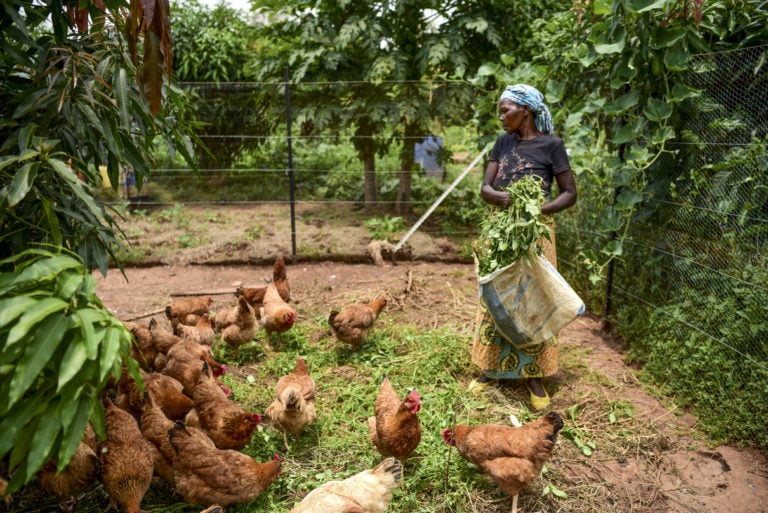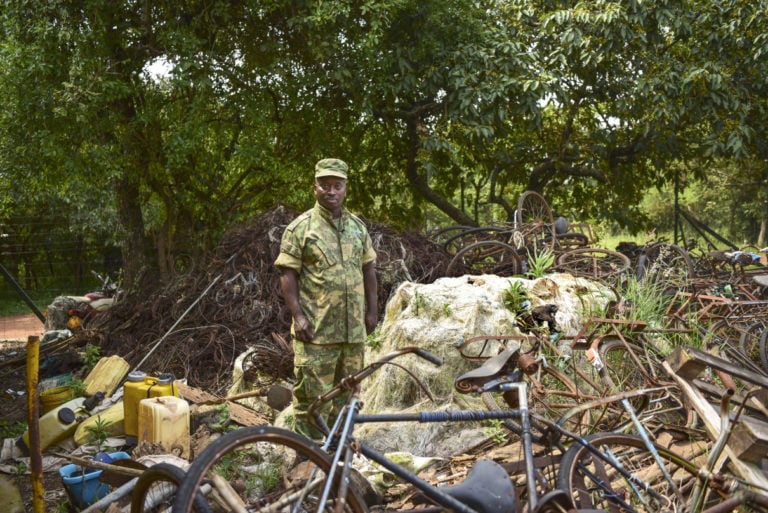Poaching in Akagera National Park (ANP) has gone down significantly in recent years, a change related to the improved relationship between park management and the community on ANP’s periphery.
- An informal network of community members, including former poachers, that delivers information to the ANP security team has bolstered internal response to potential poachers even before they enter ANP limits.
- High employment rates within the periphery community, significant reinvestment in infrastructure projects and income generation opportunities.
- It also includes a sustained relationship through informal events like sports have increased positive relationships between the park and periphery community.
The first time Bugingo Gaspard illegally entered Akagera National Park in Rwanda, he was 10 years old. With no fence separating the now 112,200-hectare (277,300-acre) protected area from the agricultural plots of community members, families in the neighboring villages frequently grazed livestock past the park limits, sharing grass with impala, zebra and other protected wildlife.
While grazing a herd of cattle, Gaspard and his friends were startled by a bushbuck, an antelope native to the region. Together the children stoned the animal to death, acting mostly from a kind of misguided childish curiosity.
“At that time I was at a bad age,” Gaspard says. “I was young, so I found that fun.”
Gaspard grew up in Nyankora village on the outskirts of Akagera park. Now 40 years old, he has worked as a chief builder for construction projects in the park for the last nine years. His father, Nayo Landuard, settled the family there in 1973. A father of 11, Landuard says he felt he had little choice when he began poaching meat in order to keep his family from starving.
“I was a good poacher,” Landuard remembers, sitting with his family outside their home in the late afternoon sun. “I used to do that for my babies, for my kids.”

Bugingo Gaspard (r), 40, and his father, Nayo Landuard, 72, outside of Landuard’s family home in Nyankora village in February, 2020. Photo by Maggie Andresen.
Although occasionally apprehended by park rangers and punished with severe beatings, Languard was not deterred. “It was like my restaurant where I could get food for my kids,” he says, adding he only stopped in 2001. “By the time I was getting older, my wife told me to stop or else our kids would follow my way, and would be poachers like me.”
Gaspard remembers the beatings his father would give him to stop entering the park as an adolescent, though they didn’t always work. “I used to go with some other crazy kids who were the same age as me,” he says. “My dad used to tell me to stay home.”
A heavy history
Akagera National Park was established in 1934; the original size of more than 250,000 hectares (618,000 acres) accounted for nearly 10% of the land area of modern-day Rwanda.
Violence permeated the protected area and its surrounding communities during Rwanda’s civil war, from 1990 to 1993. People and wildlife alike became casualties as the rebel-led Rwandan Patriotic Front and national army of Rwanda’s former dictator, Juvenal Habyarimana, clashed in firefights.
To accommodate thousands of repatriated refugees returning from Uganda and Tanzania following the 1994 genocide, a massive resettlement project undertaken in 1997 shrunk Akagera’s surface area by two-thirds. Conflict between people and wildlife increased as animals destroyed newly planted agricultural plots, and casualties from lions, hippos and leopards fueled discontent in communities at the park’s periphery.

Boaz Washika, originally from Kenya, is the Kennel Manager of the K9 Unit of Akagera Park. He has been a ranger here for the last four years, and is seen here at Akagera Park’s K9 Kennel. Photo by Maggie Andresen.
“Some people would poach just when they wanted to get meat, but some other people were going there taking revenge because the animals would kill their people,” Gaspard remembers of the chaos at that time.
“There was no law and order here,” says Jes Gruner, Akagera’s park manager for the past 10 years. Gruner is a representative of African Parks, a nonprofit organization partnering with governments and local communities for long-term park management and rehabilitation in 17 national parks across the continent. In 2010, a for-profit partnership named the Akagera Management Company (AMC) was established between African Parks and the Rwanda Development Board, made to steer Akagera back to prosperity.
In 2013, AMC erected a park fence to limit the frequent and devastating conflicts between people and wildlife. That year, a total of 1,997 snares were confiscated inside the park. A year later, the number dropped to 595. In 2019, 25 snares were recorded, seized either in transit to the park by local authorities, or found within its limits.
“We had a lot of poachers,” says Ntirunkunduye “Deputy” Sylvestre, Akagera’s deputy head of law enforcement. Sylvestre has worked with Akagera National Park since 1999, recalling significant arrests in his early years as a ranger. He’s seen acute changes in the park’s anti-poaching response over the past two decades, citing access to resources such as a well-trained K9 unit, advanced GPS infrastructure, and a helicopter as crucial for securing baseline order in the park.
“We manifested a lot of change in the materials for the rangers,” he says, guiding a path around piles of confiscated snares, bicycles, machetes and fishing nets collected near the park headquarters law enforcement station. “It facilitates us to arrive in action immediately.”
A community network
In Cyarubare village, near Akagera’s gates, a small marketplace hosts vendors selling a variety of meats, vegetables and fruits. One woman begins wrapping what’s left of her fish stocks, finished with the day’s sales.
Zanika Savera has been a member of the Copabarwi fishing cooperative for the past five years. She serves as the cooperative’s adviser, coordinating with her fellow members to hire local fishers to work under security supervision, casting in Akagera’s lakes and selling their catch in Kigali, the Rwandan capital. The fish are also sold in the local community for a reduced price.
“This used to be for rich people,” Savera recalls of the time only poachers fished in the park. “Now we are good, we are getting them all the time.”

Zaninka Savera, advisor and member of the Copabarwi fish cooperative, wraps fish for a customer at her market stall in Cyarubare village. Photo by Maggie Andresen.
Savera says the legal pathway to long-term financial gain offered through community cooperatives also serves as an incentive for poachers to stop entering the park illegally. She says she considers it an imperative of her cooperative to prevent poachers from depleting the park’s fish stocks, and takes action when she can.
“I found people who were trying to poach,” Savera says. She encountered them at a location where she would pick up the day’s catch from supervised fishermen. “I told them, ‘Please make a cooperative, I’m in a cooperative and I’m working with the community liaison officer from the park. I will inform them to also organize something for you. You can get fish as well as I do. And then you can sell them in different places, then you get money instead of poaching.’”
The infusion of direct and indirect support to the communities on Akagera’s periphery has sparked an informal community-led process of reporting potential poachers to park law enforcement and local authorities.

Kandida Mukagasikare feeds the chickens involved in the farming project at Akagera Park’s community center earlier this year. Photo by Maggie Andresen.
“We have that good community who has a good will of keeping the park safe,” says Boaz Washika, a 36-year-old ranger and kennel manager of the Akagera K9 unit for the past four years. “You find they really work hand-in-hand with law enforcement to keep the place safe.”
“You don’t go out searching for informers,” Gruner says. “They sort of reveal themselves. It doesn’t have to be a former poacher. It can be an old lady selling something in the market, it could be somebody owning a bar. That shows community buy-in.”
Gruner says a financial reward is provided to community members for tangible, evidence-based information that leads to the thwarting of poachers, and that about 40% of the information collected from community informers ends up being true. The continuing incentive, however, is in the long-term community investment born of the park’s relationship with the neighboring community.
“If you do find poachers or illegal activities,” Gruner says,” it’s the people who are actually coming from 20 or 30 kilometers away,” about 12 to 19 miles. “They’re not people who live on the park periphery.”
Former poacher Landuard hasn’t entered the park illegally to hunt animals in 19 years. He says his influence in recruiting others to start poaching years ago was essential in helping to curb the practice and to keep his peers involved in reporting other potential poachers as well.
“I was the poacher, I used to encourage other people to poach,” Landuard says. “I was one who came up with the idea, I was the really serious one. So if I’m the one who told you to poach, you should also stop when I tell you.”

Rangers coming off of lake patrol come ashore to the Pescarie patrol station in February, 2020. Photo by Maggie Andresen.
Tracking community gains
The metrics of impact and success that coalesce in community conservation efforts are difficult to measure definitively, and fuel much debate among researchers and conservationists.
“Any metrics that can be used to define whether or not something is beneficial to both wildlife and communities living adjacent to protected areas, must at the very core … be defined through the eyes and the understanding of communities,” says Elizabeth Gitari, a conservation lawyer, expert and chairperson of the East African Wildlife Society. “Whether or not they feel that they are bona fide participants in conservation, or that they’re just looking by on the sidelines … with zero benefits.”
The pillar of community partnership in the African Parks model is essential to its goal of sustainable long-term park management. According to park officials, 80% of Akagera’s full-time contracted staff are recruited from the communities surrounding the park.
More than $180,000 per month is spent on staff salaries alone. There’s also a national policy that combines 10% of the individual tourism revenues from Rwanda’s four national parks — Akagera, Volcanoes, Nyungwe and Gishwati — and divides and disburses the total directly back to the communities living alongside those protected areas for community infrastructure projects.

Ntirunkundiye Sylvestre, known as ‘Deputy,’ has served Akagera Park for the last 21 years, in front of confiscated poaching snares, fishing line, bicycles, and machetes. As Deputy Head of Law Enforcement, he is in charge of anti-poaching efforts at the park. Photo by Maggie Andresen.
“On top of that we have our own programs,” Gruner says. “If we accumulated that in our community budget, together we’re spending over three-quarters of a million dollars on community work annually.”
In the past five years, lions and rhinos have been successfully reintroduced to Akagera’s ecosystem. The buffalo population has grown from 500 in 2010 to more than 3,500 today, according to Gruner. As economic opportunities for communities on the park’s periphery have expanded in recent years, wildlife in Akagera has thrived.
“Poachers are the minority, communities actually feel they get more benefit from the park,” Gruner says. “We’re going to secure this place for the majority.”
Gaspard, who has dedicated his career to serving the park he once poached from, speaks to this best.
“I’m thankful that our community has understood why we should stop poaching the animals,” Gaspard says. “I have also seen the value of the park for the community people, for Rwanda, for Africa, and for the world. And that made me change.”
The original story was published by Mongabay

As Park rangers, Akagera management Company we will keep sustainable and sovereignty of our park because it has changed positively our day today life not only us who work in but country wide, there fore protection of this park is our major task, together we can do more